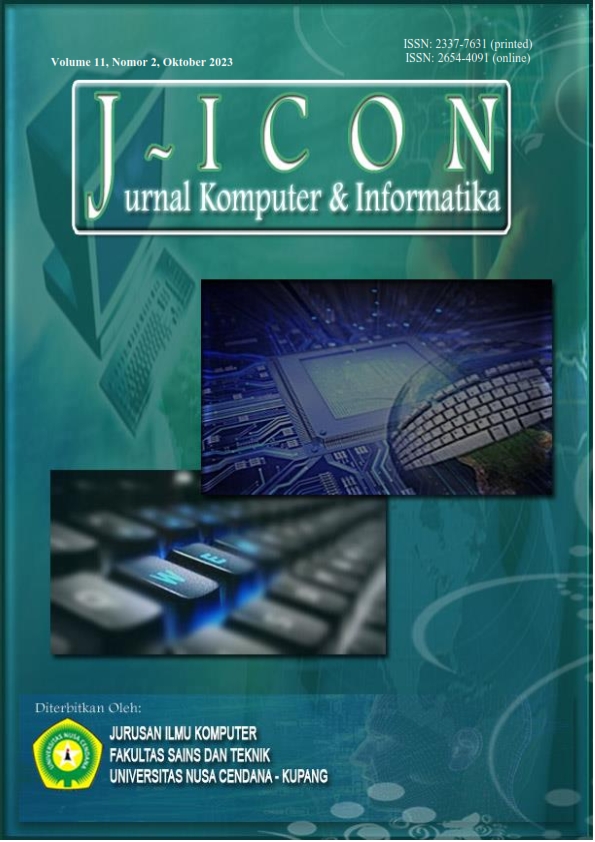DECISION SUPPORT SYSTEM FOR NATURAL DISASTER AID RECIPIENTS USING THE TOPSIS METHOD
(CASE STUDY: MAJENE DISTRICT REGIONAL DISASTER MANAGEMENT AGENCY OFFICE)
Abstract
This research aims to produce a website-based system by implementing the TOPSIS method into the system to solve the problem of determining prospective recipients of natural disaster assistance. The type of research used is the type of development using the Waterfall model. The test subjects in this study were the Majene Regency Regional Disaster Management Agency staff. Data on the response of the staff of the Regional Disaster Management Agency Office regarding the implementation of the TOPSIS method in the decision support system for recipients of natural disaster assistance was collected through a questionnaire. The data collected in the trial was then analyzed using quantitative analysis techniques. The results of the research data show that (i) The results of the application of the TOPSIS method have succeeded in providing recommendations for determining prospective recipients of natural disaster assistance, (i) The results of testing with blackbox test show that this decision support system has no defects or errors, which means that the system created already meets the functional requirements, (ii) The User Acceptance Test (UAT) test produced 82% of users who stated that they strongly agreed with the existence of this decision support system which could assist in determining potential recipients of natural disaster assistance according to the criteria used.
Downloads
References
A. M. A. Septian, R. Afwani, and M. A. Albar, “Implementasi Metode Simple Additive Weighting (SAW) dalam Sistem Pendukung Keputusan Penentuan Penerima Bantuan Korban Bencana Alam Gempa (Studi Kasus: BPBD Lombok Barat),” JTIKA, vol. 2, no. 2, pp. 196–207, 2020, doi: 10.29303/jtika.v2i2.101.
I. Muzakkir, “Penerapan Metode TOPSIS Untuk Sistem Pendukung Keputusan Penentuan Keluarga Miskin pada Desa Panca Karsa II,” ILKOM Jurnal Ilmiah, vol. 9, no. 3, pp. 274–281, 2017, doi: 10.33096/ilkom.v9i3.156.274-281.
M. Hidayat, “Penentuan Pemberian Bantuan Program Keluarga Harapan dengan Metode TOPSIS,” Jurnal Penelitian dan Pengabdian Kepada Masyarakat UNSIQ, vol. 5, no. 1, pp. 98–106, 2018, doi: 10.32699/ppkm.v5i1.454.
H. Nalatissifa and Y. Ramdhani, “Sistem Penunjang Keputusan Menggunakan Metode TOPSIS Untuk Menentukan Kelayakan Bantuan Rumah Tidak Layak Huni (RTLH),” MATRIK : Jurnal Manajemen, Teknik Informatika dan Rekayasa Komputer, vol. 19, no. 2, pp. 246–256, 2020, doi: 10.30812/matrik.v19i2.638.
BNPB, “Definisi Bencana,” BNPB.
R. Biasrori, I. W. A. Arimbawa, and I. W. W. Wedashwara, “Sistem Pendukung Keputusan Konsumsi Listrik Dengan Implementasi Iot dan Fuzzy Rule Mining,” JIRE, vol. 2, no. 1, 2019, [Online]. Available: http://e-journal.stmiklombok.ac.id/index.php/jire.
K. Cahyo, M. Martini, and E. Riana, “Perancangan Sistem Informasi Pengelolaan Kuesioner Pelatihan Pada PT Brainmatics Cipta Informatika”, josh, vol. 1, no. 1, pp. 45-53, Oct. 2019. [Online]. Available: https://ejurnal.seminar-id.com/index.php/josh/article/view/44.
E. Alawiah and D. Putri, “Sistem Pendukung Keputusan Pemberian Bantuan Rs-Rutilahu dengan Metode TOPSIS pada Desa Kotabatu Ciomas Kabupaten Bogor”, techno, vol. 16, no. 1, pp. 73-78, Mar. 2019, doi: 10.33480/techno.v16i1.439.
W. Firgiawan, S. Cokrowibowo, and N. Zulkarnaim, “Komparasi Algoritma SAW, AHP, dan TOPSIS dalam Penentuan Uang Kuliah Tunggal (UKT),” J-CIS, vol. 3, no. 1, pp. 1–11, 2019, doi: 10.31605/jcis.v1i2.426.
A. Fadel, M. Mardayulis, and P. Yunita, “Aplikasi Sistem Pakar Pusat Informasi Konseling Remaja (PIK-R) Di SMAN 2 Dumai dengan Metode Backward Chaining menggunakan Bahasa Pemograman PHP,” INFORMATIKA, vol. 10, no. 2, p. 47, 2019, doi: 10.36723/juri.v10i2.115.
S. I. Luthfiyah, R. C. N. Santi, “Sistem Pendukung Keputusan (SPK) Penentuan Algoritma Dan Metode Penelitian dengan Metode Simple Additive Weighting (SAW),” JIRE, vol. 5, no. 2, 2022, doi: 10.36595/jire.v5i2.678.
Copyright (c) 2023 Yunita Hadrianti J.A, Musyirifah Musyirifah, Farid Wajidi

This work is licensed under a Creative Commons Attribution 4.0 International License.
The author submitting the manuscript must understand and agree that if accepted for publication, authors retain copyright and grant the journal right of first publication with the work simultaneously licensed under a Creative Commons Attribution (CC-BY) 4.0 License that allows others to share the work with an acknowledgment of the work’s authorship and initial publication in this journal.
 Yunita Hadrianti J.A(1*)
Yunita Hadrianti J.A(1*)




